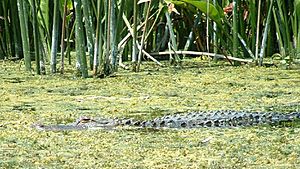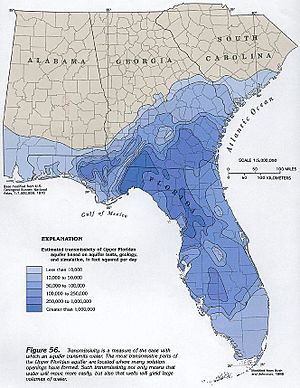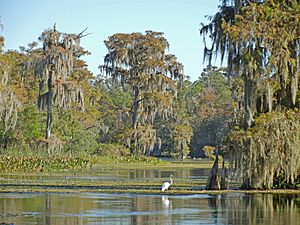Wakulla Springs facts for kids
Quick facts for kids Wakulla Springs |
|
|---|---|

Wakulla Springs as it empties into the Wakulla River
|
|
| Location | Florida, United States |
| Depth | 350 ft (110 m) |
| Length | 31.99 mi (51.48 km) |
| Geology | Limestone |
| Difficulty | Advanced cave diving |
| Cave survey | Woodville Karst Plain Project |
Wakulla Springs is a huge natural spring located about 14 miles (23 km) south of Tallahassee, Florida. It is also about 5 miles (8.0 km) east of Crawfordville in Wakulla County, Florida. This amazing natural wonder is protected within the Edward Ball Wakulla Springs State Park.
Contents
Exploring Wakulla Springs
Wakulla Springs is a large cave system that looks like tree branches. It formed underground in the Floridan Aquifer, which is a huge natural water storage area. This aquifer is found under the Woodville Karst Plain in northern Florida.
Wakulla Springs is known as a first magnitude spring. This means it releases a very large amount of water. It is a main spot where water from the Floridan Aquifer comes to the surface. The spring forms the Wakulla River, which flows about 9 miles (14 km) southeast. It then joins the St. Mark's River. After flowing for another 5 miles (8.0 km), the St. Mark's River empties into the Gulf of Mexico.
History and Discoveries
Scientists became interested in Wakulla Springs way back in 1850. That's when Sarah Smith reported seeing the bones of an ancient mastodon at the bottom. Since then, scientists have found bones from at least nine other extinct mammals. These animals lived during the last glacial period. Their remains were found deep inside the cave, up to 1,200 feet (360 m) from the entrance. Today, you can still see fossilized mastodon bones about 190 feet (58 m) deep.
Early Studies and Fossils
The Florida Geological Survey (FGS) started its first study in 1930. Geologist Herman Gunter led this work. He focused on finding fossils in the spring's basin. He used special hard hat diving gear and tools like a dredge. A mastodon found during his work is now at the Museum of Florida History.
The FGS did more studies in 1955, 1956, and 1962. Stanley J. Olsen, a scientist who studied animal fossils, was in charge. His team of six divers from Florida State University found more animal fossils deep in the spring. They also found signs of early humans, like bone and stone tools.
Modern Cave Exploration
A big exploration of Wakulla Springs happened in 1987. Dr. Bill Stone led this expedition. The team, including Sheck Exley and Wesley C. Skiles, went deep into the cave system. They explored up to 4,160 feet (1,270 m) from the entrance. Skiles filmed the trip for a National Geographic special. In 1998 and 1999, Stone led another huge project called Wakulla 2. Over 100 volunteers from around the world took part.
Ancient Human Life
Upper Paleolithic-Paleo-Indians lived near Wakulla Springs over 13,000 years ago. These people were descendants of groups who came to North America from eastern Asia. This happened during the Pleistocene Ice Age. The Wakulla Lodge Site is one of several very old sites in North Florida. During that time, Florida was very dry. This made freshwater spots like Wakulla Springs attractive to large animals. This likely brought the Paleo-Indians to the area.
Ancient Animal Life
Many amazing ancient animals once lived near Wakulla Springs. Their remains have been found here.
- American mastodon (Mammut americanum)
- Giant ground sloth (Eremotherium laurillardi)
- Saber-toothed tiger (Smilodon populator)
- Columbian mammoth (Mammutus columbi)
- Ancient bison (Bison antiquus)
- Equus (Equus scotti)
- Short-faced bear (Arctodus simus)
- Miocene dugong (Metaxytherium crataegense)
- American lion (Panthera leo atrox)
Animals Living Today
Today, you can find many different animals in and around Wakulla Springs.
- West Indian manatees
- White-tailed deer
- North American river otters
- American alligators
- Suwannee River cooters (Pseudemys suwanniensis)
- Snapping turtles
- Softshell turtles
- Limpkins
- Purple gallinules
- Herons (like egrets)
- Bald eagles
- Anhingas
- Ospreys
- Common moorhens
- Wood ducks
- Black vultures
- Turkey vultures
Water Systems of Wakulla Springs
The Underwater Cave System
The Wakulla cave system is like a huge underground maze of water tunnels. About 12 miles (19 km) of these tunnels have been explored and mapped. The tunnels are usually long and deep, about 300 ft or 91 m deep. Sometimes, these tunnels open into larger rooms. The longest tunnel goes south from the spring for over 3.8 miles (6.1 km). Four other tunnels, including one from Leon Sinks, connect to this main tunnel. Most of these connecting tunnels have been fully explored.
On December 15, 2007, divers from the Woodville Karst Plain Project made a big discovery. They connected the Wakulla Springs and Leon Sinks cave systems. This created the Wakulla-Leon Sinks cave system. It is now the longest underwater cave in the United States. It is also the sixth largest in the world. It has a total of 31.99 miles (51.48 km) of explored passages.
How Much Water Flows?
The spring releases a huge amount of water every day. It flows at about 200–300 million US gallons (760,000–1,140,000 m3) of water daily. On April 11, 1973, a record amount of water flowed from the spring. It was measured at 14,324 US gallons (54,220 L) per second. This is equal to 1.2 billion US gallons (4,500,000 m3) per day!
Wakulla Springs in Movies
Wakulla Springs has been a popular spot for filming movies. Starting in 1938, several early Tarzan films were shot here. This included Tarzan's New York Adventure starring Johnny Weissmuller. Other movies filmed at Wakulla Springs include Creature from the Black Lagoon and Revenge of the Creature. Also, Night Moves, Airport '77, and Joe Panther were filmed here.
Much of this movie history started with Edward Ball. He bought the land around Wakulla in 1934. At first, Wakulla was a quiet resort. But this changed when Ball hired a new manager, Newt Perry. Perry helped make Wakulla Springs famous. He had worked with MGM at Silver Springs on the movie Tarzan Finds a Son!.
Perry also made short underwater films at Wakulla. One famous film was What a Picnic!. In it, a picnic scene was set up underwater. Teenagers would dive down and pretend to have lunch. These films showed off the clear water of Wakulla Springs. Perry is also known for bringing the Metro-Goldwyn-Mayer Tarzan film crews to Wakulla Springs. The spring's environment was used to look like Africa in the movies.
Grantland Rice also filmed parts of a lesser-known movie at Wakulla Springs. It was called Amphibious Fighters (1943). This movie featured an underwater battle scene.
Fun Things to Do
Wakulla Springs Lodge
In 1931, Edward Ball, a businessman, bought land in Tallahassee, Florida. Construction on the Wakulla Springs Lodge began in 1935. Edward Ball hired architects known for their Mediterranean-style buildings. The lodge was first built as a guest house. After his death in 1981, it became a hotel.
The lodge is now a hotel with twenty-seven rooms. It is also part of Historic Hotels of America. This is a program of the National Trust for Historic Preservation.
In 2002, artists started working to restore the lodge's ceiling. The State of Florida helped pay for this work. Each picture on the 5,800 square-foot ceiling shows historic Florida scenes. The art combines European folk art with Native American styles.
Hiking Trails
Wakulla Springs has many trails for hiking. You can explore up to 9 miles of paths here.
Boat Tours
Since 1875, glass-bottom boat tours have been a popular attraction at Wakulla Springs. These tours let you see into the clear water below. However, these tours don't happen as often now. This is because the water is not as clear as it used to be.
Protecting Wakulla Springs
In the late 1990s, the number of Florida applesnails dropped a lot. The famous Limpkin bird, which eats these snails, also left by 1999. Jim Stevenson, a conservationist, says that what was once a lively ecosystem is becoming a "biological desert." The Wakulla Springs water basin stretches far north into Florida and even into southern Georgia.
Water pollution is a big problem. Storm water runoff and human waste with high nitrates seep into the underground aquifer. This polluted water then flows out of Wakulla Springs.
Steps are being taken to help clean up the spring. The City of Tallahassee built Cascades Park. This park helps manage storm water drainage. It reduces the amount of polluted water entering the basin. The city has also made rules about its wastewater. To help reduce pollution, we can use less harsh fertilizers. We also need better ways to handle waste than septic tanks. Septic tanks can leak large amounts of nitrates into the soil and, eventually, the spring.




